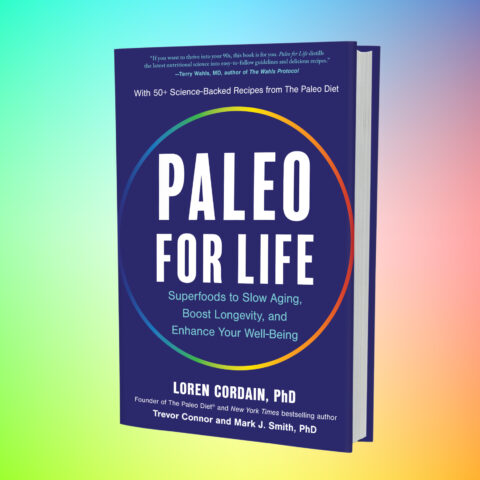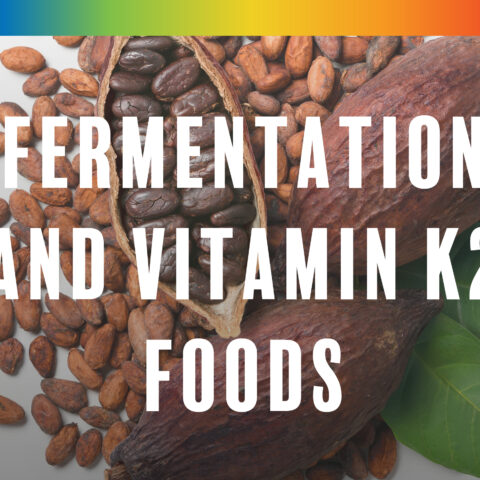3 Micronutrient Ratios to Keep in Balance

You might have heard that at The Paleo Diet®, we don’t focus on macronutrient ratios. In other words, you can have a varied mix of proteins, carbs, and fats—as long as they are relatively balanced and from healthy sources. However, this rule doesn’t always apply to micronutrient ratios.
Some nutrients have a symbiotic relationship to each other, and your body needs to have them in a certain proportion in order to operate at its best. Specifically, Dr. Loren Cordain’s groundbreaking research found there are three critical nutrient ratios that we need to keep in balance for optimal health, that are unfortunately out of balance in a typical Western diet:
- Calcium to magnesium
- Sodium to potassium
- Omega-6 to omega-3 fatty acids
While adopting The Paleo Diet can already set you up for success, there are also certain foods you can eat more of to get your ratios back into a healthy balance.
1. The Calcium-to-Magnesium Ratio
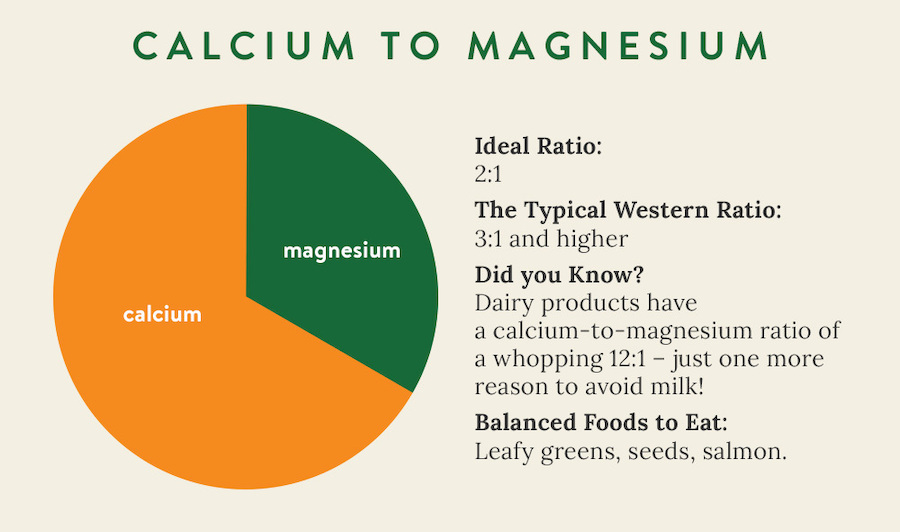
“Milk: It does a body good.”
Over the past hundred years or so, calcium became ubiquitous with dairy. Doctors (and advertisers) told us that in order to get the calcium we need for strong teeth and bones, you must drink plenty of milk.
There are two major problems with this: First, milk is not the healthiest source of calcium. It’s a common allergen and contains hormones that are meant for a growing calf, not a human. These hormones can be harmful to us and can lead to all kinds of health problems. Second, getting more calcium without also increasing your magnesium intake can cause even more problems down the road.
Calcium and magnesium regulate one another in the body, and a deficiency in one can lead to poor absorption in the other. [1, 2] In fact, excess calcium paired with a magnesium deficiency can lead to inflammation, cancer, and heart disease, which is why it’s so important not to simply focus on getting more calcium. [3] And while it’s important to keep your calcium and magnesium in the correct balance, consuming too much calcium has a bigger health impact than consuming too much magnesium. Unfortunately, researchers estimate that up to 75% of the U.S. population may be magnesium deficient. [4]
To keep calcium in balance with magnesium, be mindful that the ideal ratio of calcium to magnesium is about 2:1 (or technically between 1.7:1 and 2.1:1), while the typical Western ratio is 3:1 or even higher. [5, 6]
It’s also worth noting that modern farming practices may also lower the amount of magnesium that naturally occurs in food. A report published by the North American Institute of Medical Herbalism found that the magnesium content of apples had gone down over 82% over the course of 80 years. [7]
How to Keep Them in Balance
Eating plenty of green leafy vegetables, like spinach, Swiss chard, turnips, and beet greens are a good way to get both calcium and magnesium. Pumpkin seeds, sesame seeds, and sunflower seeds can also help. Salmon and dark chocolate are also good ways to get a little extra magnesium in your diet.
2. The Potassium-to-Sodium Ratio
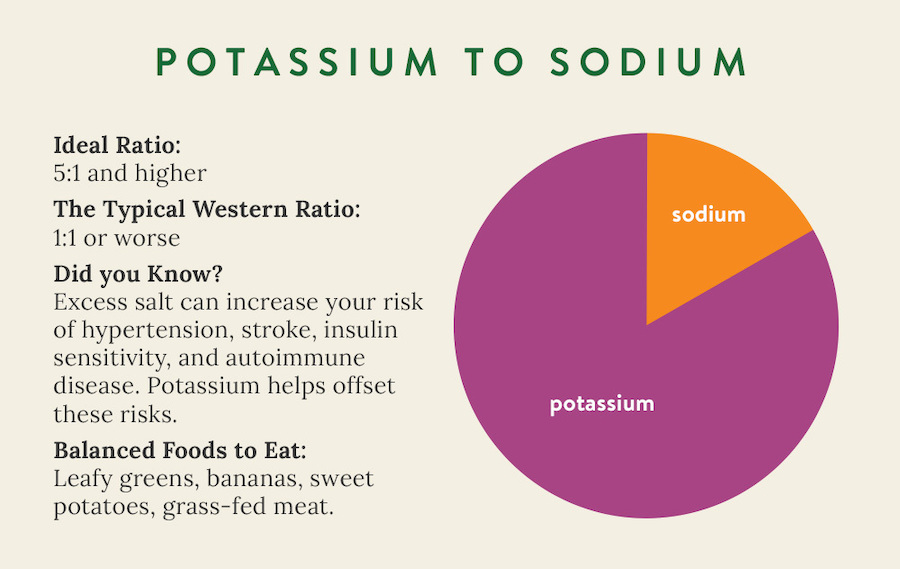
Processed and convenience foods are high in sodium, and you often might not even notice it. Did you know that the majority of Americans get more salt in their diet from bread than from any other food?
While too much sodium comes with its own set of problems, it also makes it nearly impossible to get enough potassium to balance it out. According to Dr. Cordain’s research, the ideal potassium–to–sodium ratio is at least 5:1, but the typical American diet is often closer to 1:1 and sometimes even worse. [8]
Excess salt can be very damaging to your body. It increases the risk of hypertension, stroke, insulin resistance, and autoimmune disease. [8–11] Reducing salt in all forms (yes, even sea salt and pink Himalayan salt!), and getting more potassium in your diet helps mitigate these risks.
How to Keep Them in Balance
Bananas are great, but they’re not the only source of potassium! Leafy greens like chard and spinach are also great sources, and sweet potatoes are rich in potassium too. Be sure to stick with fresh meats (not cured or processed) as well. [12]
3. The Omega-6-to-Omega-3 Ratio
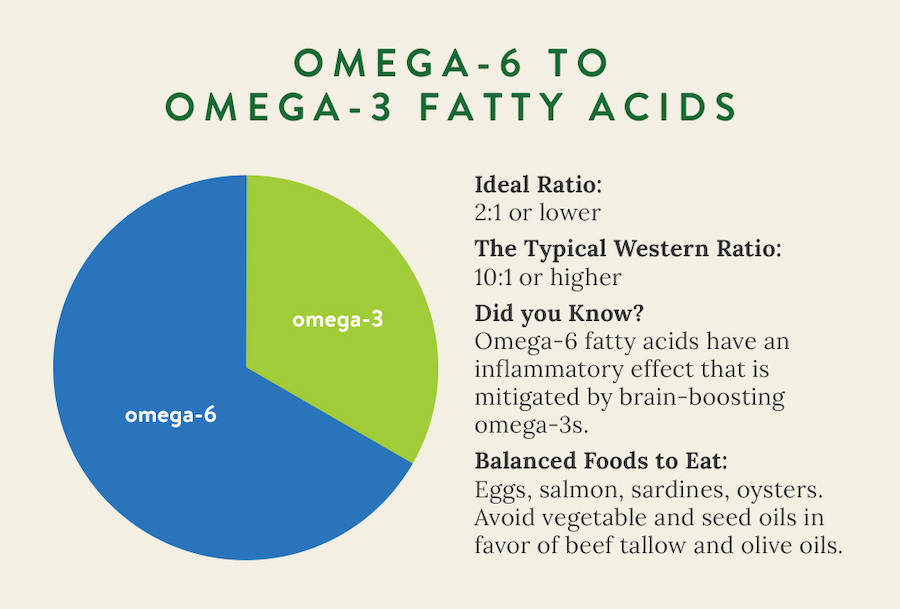
Omega-6 fatty acids are sometimes vilified as the pro-inflammatory fatty acid that we should avoid, but the truth is that we need both omega-6 and omega-3 fatty acids—and they need to be in balance with one another. Omega-6 fatty acids can cause inflammation, but only when they are out of balance with omega-3. [13]
Many Americans tend to get too many omega-6 fatty acids in their diet from a lot of grains and the vegetable oils used in cooking, baking, and processed foods. Meanwhile, the average intake of omega-3 fatty acids tends to be too low.
Omega-3 fatty acids come in many forms, so it is important to consume enough of the long-chain omega-3 fatty acids—eicosapentaenoic acid (EPA) and docosahexaenoic acid (DHA)—which have an array of health benefits. This is because these are the two forms our bodies can use. We can convert the other forms (which are mostly found in plant foods) to DHA and EPA, but our ability to convert them is quite limited. We can only convert less than 10% of what we eat. [14] Fish and fish oil supplements are the easiest way to get these important fats.
While the ideal ratio of omega-6 to omega-3 fatty acids is between 2:1 and 1:1, the typical Western diet is closer to 10:1. [14, 15] And if you are consuming mostly the other forms of omega-3s—the forms we can’t convert very well—your true ratio of usable omega-3s to omega-6s can be even worse than that. Keeping this ratio in balance is important for decreasing inflammation. Plus, omega-3 fatty acids are the primary lipid used in the brain, so it’s important to get plenty of those as well. [16]
How to Keep Them in Balance
Keep in mind that nuts and seeds overall are higher in omega-6 fatty acids, so be sure to balance them out with plenty of pasture-raised eggs, oysters, and fatty fish like salmon, sardines, and herring.
Your cooking oil is also important. Skip the safflower, sunflower, corn, cottonseed, sesame, and peanut oils in favor of beef tallow or duck fat for high-heat cooking. For moderate heat, try coconut, avocado, walnut, macadamia nut, or extra-virgin olive oil.
Why Eating Paleo Balances Your Micronutrient Ratios
Luckily, eating The Paleo Diet naturally provides the micronutrient balances your body needs. Why is this? Mostly, it’s because you’re eliminating the big trigger foods that throw the majority of the population off balance, like salty, oily processed foods and dairy products. Instead, you’re getting plenty of fresh produce and healthy fats, which will only help balance all of these micronutrient ratios in your favor.
Want to go a bit deeper? It can be hard to keep track of something as complex as nutrient ratios on your own. If you want to see how on target you are, the Cronometer app is a great resource. Use it to track your diet and your ratios are automatically calculated for you.
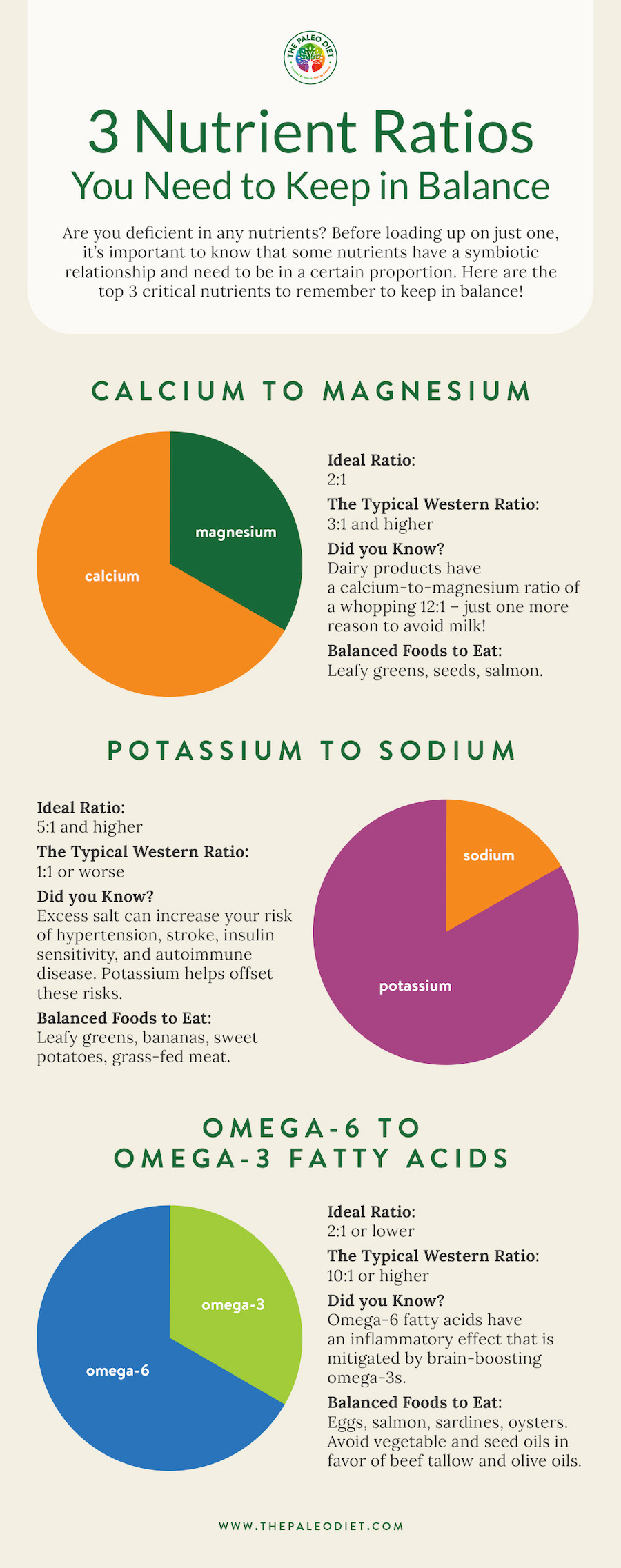
References
[1] Zhang A, Cheng TPO, Altura BM. Magnesium regulates intracellular free ionized calcium concentration and cell geometry in vascular smooth muscle cells. Biochimica Et Biophysica Acta Bba – Mol Cell Res 1992;1134:25–9. https://doi.org/10.1016/0167-4889(92)90024-6
[2] D’Angelo EK, Singer HA, Rembold CM. Magnesium relaxes arterial smooth muscle by decreasing intracellular Ca2+ without changing intracellular Mg2+. J Clin Invest 1992;89:1988–94. https://doi.org/10.1172/jci115807
[3] Shah NC, Shah GJ, Li Z, Jiang X-C, Altura BT, Altura BM. Short-term magnesium deficiency downregulates telomerase, upregulates neutral sphingomyelinase and induces oxidative DNA damage in cardiovascular tissues: relevance to atherogenesis, cardiovascular diseases and aging. Int J Clin Exp Med 2014;7:497–514.
[4] Beckstrand RL, Pickens JS. Beneficial Effects of Magnesium Supplementation. J Evidence-Based Complementary Altern Medicine 2011;16:181–9. https://doi.org/10.1177/2156587211401746
[5] Carafoli E. Calcium signaling: A tale for all seasons. Proc National Acad Sci 2002;99:1115–22. https://doi.org/10.1073/pnas.032427999
[6] Rosanoff A, Dai Q, Shapses SA. Essential Nutrient Interactions: Does Low or Suboptimal Magnesium Status Interact with Vitamin D and/or Calcium Status?12. Adv Nutr 2016;7:25–43. https://doi.org/10.3945/an.115.008631
[7] Bergner P. The Healing Power of Minerals and Trace Elements. North American Institute of Medical Herbalism, Inc 2003.
[8] Sebastian A, Cordain L, Frassetto L, Banerjee T, Morris RC. Postulating the major environmental condition resulting in the expression of essential hypertension and its associated cardiovascular diseases: Dietary imprudence in daily selection of foods in respect of their potassium and sodium content resulting in oxidative stress-induced dysfunction of the vascular endothelium, vascular smooth muscle, and perivascular tissues. Med Hypotheses 2018;119:110–9. https://doi.org/10.1016/j.mehy.2018.08.001
[9] Zhao X, Zhang Y, Zhang X, Kang Y, Tian X, Wang X, et al. Associations of urinary sodium and sodium to potassium ratio with hypertension prevalence and the risk of cardiovascular events in patients with prehypertension. J Clin Hypertens 2017;19:1231–9. https://doi.org/10.1111/jch.13104
[10] Okayama A, Okuda N, Miura K, Okamura T, Hayakawa T, Akasaka H, et al. Dietary sodium-to-potassium ratio as a risk factor for stroke, cardiovascular disease and all-cause mortality in Japan: the NIPPON DATA80 cohort study. Bmj Open 2016;6:e011632. https://doi.org/10.1136/bmjopen-2016-011632
[11] Wilck N, Matus MG, Kearney SM, Olesen SW, Forslund K, Bartolomaeus H, et al. Salt-responsive gut commensal modulates TH17 axis and disease. Nature 2017;551:585–9. https://doi.org/10.1038/nature24628
[12] Morrissey E, Giltinan M, Kehoe L, Nugent AP, McNulty BA, Flynn A, et al. Sodium and Potassium Intakes and Their Ratio in Adults (18–90 y): Findings from the Irish National Adult Nutrition Survey. Nutrients 2020;12:938. https://doi.org/10.3390/nu12040938
[13] Keim SA, Jude A, Smith K, Khan AQ, Coury DL, Rausch J, et al. Randomized Controlled Trial of Omega-3 and -6 Fatty Acid Supplementation to Reduce Inflammatory Markers in Children with Autism Spectrum Disorder. J Autism Dev Disord 2022:1–14. https://doi.org/10.1007/s10803-021-05396-9
[14] Swanson D, Block R, Mousa SA. Omega-3 fatty acids EPA and DHA: health benefits throughout life. Adv Nutrition Bethesda Md 2012;3:1–7. https://doi.org/10.3945/an.111.000893
[15] Simopoulos AP. The importance of the ratio of omega-6/omega-3 essential fatty acids. Biomed Pharmacother 2002;56:365–79. https://doi.org/10.1016/s0753-3322(02)00253-6
[16] Chappus-McCendie H, Chevalier L, Roberge C, Plourde M. Omega-3 PUFA metabolism and brain modifications during aging. Prog Neuro-Psychopharmacology Biological Psychiatry 2019;94:109662. https://doi.org/10.1016/j.pnpb.2019.109662
Betsy Schroeder
Betsy does research and writing for a few different websites in the natural health field after taking Masters level courses in Nutrition & Functional Medicine through the University of Western States.
More About The Author
